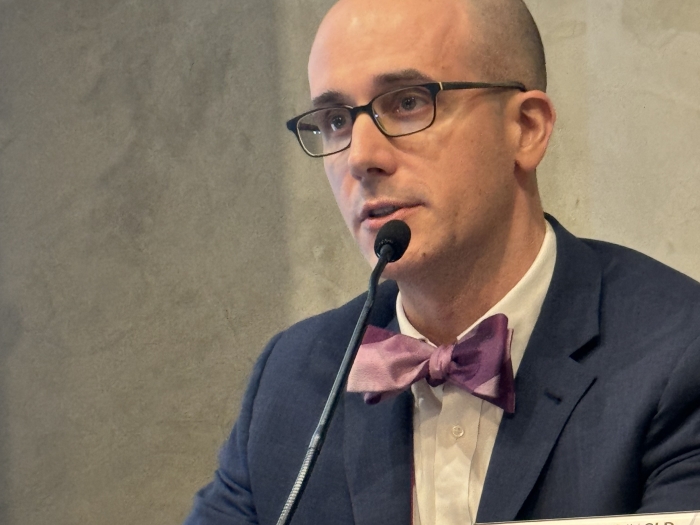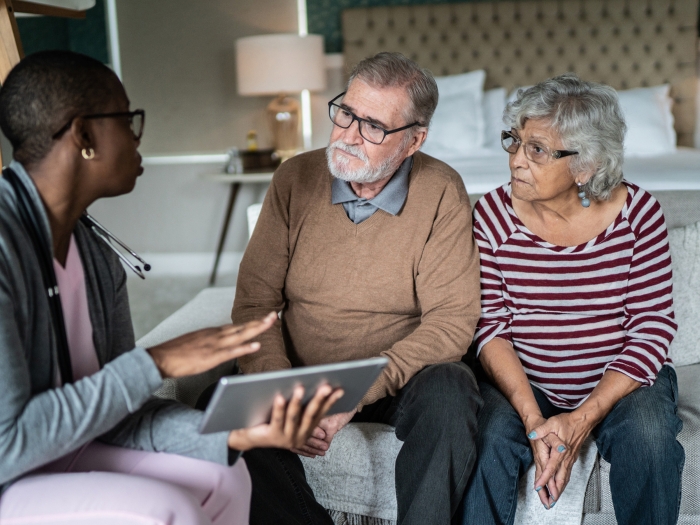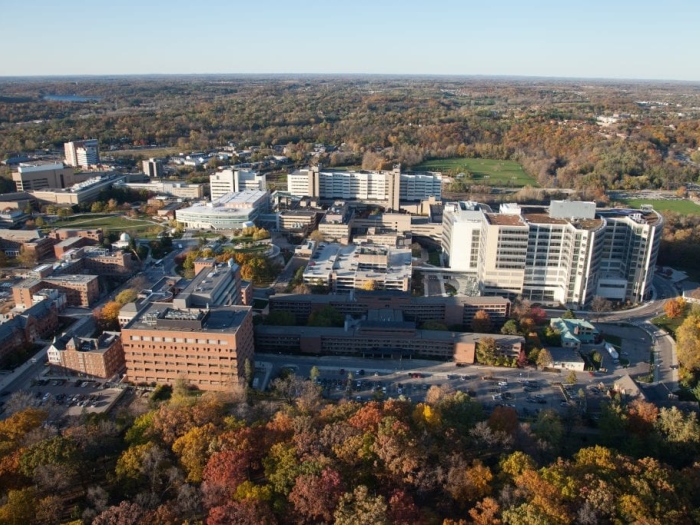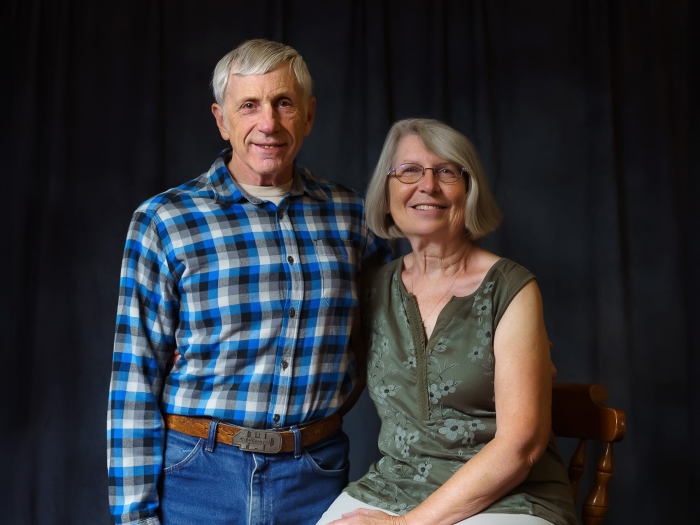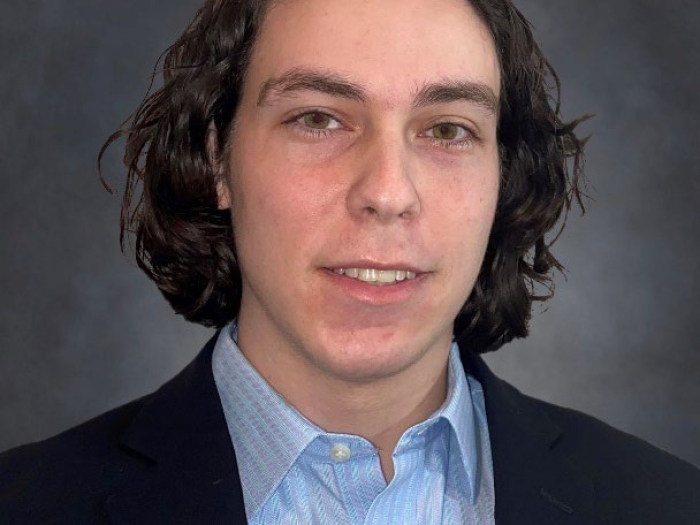As I walked down the hallway of the University of Michigan hospital, a simple sign caught my eye. Taped to a patient's door, the sign declared, "Patient uses American Sign Language (ASL)" in bold black letters. I entered the room, smiled and waved to the patient. His eyes met mine and quickly flickered away, as if I were there to speak with his daughter instead. His daughter explained he was deaf and did not communicate in spoken English. I turned to him, introduced myself and asked how he was doing. My hands and facial expressions flowed in synchrony to convey my intended emotions of interest and empathy.
His eyes lit up in surprise as he recognized ASL. His arms and upper body sprang to life, clearly forming his hands and facial expressions to describe every detail leading up to his hospitalization. Our connection was instantaneous, bound by a language and a mutual appreciation for its community, culture and pride. He taught me that a simple conversation in a patient's primary language can create a unique bond — a form of healing that extends beyond medical treatment.
My own ASL journey began fortuitously during my sophomore year at the University of Pennsylvania. I enrolled in my first ASL class to fulfill a social science requirement for my bioengineering degree. Little did I know, that first class would inspire me to take four semesters of ASL and pursue a lifelong mission to improve access to healthcare for people with disabilities.
Upon graduating from college, my budding interest in Deaf Health led me straight to Michigan Medicine — home to the Deaf Health Clinic. As a clinical research assistant, I worked closely with Drs. Michael McKee and Philip Zazove, both ASL-fluent physicians in the Family Medicine Department who established the Deaf Health Clinic. Through this work, McKee and Zazove became my mentors and support system as I explored the field of disability health.
With this new exposure to disability in medicine, I sought out disability-friendly institutions when applying to medical school. Fortunately, the University of Michigan Medical School (UMMS) had clearly shown its commitment to disability. From the learning specialist and mental health services to the faculty support from the Center for Disability Health and Wellness, UMMS offered many opportunities to further explore my interests in disability and Deaf health.
As a newly minted medical student, I recognized the need to expand disability inclusion in medical education. Very few medical schools prepare students to partner with Deaf patients, resulting in barriers to communication and adherence. Inspired by the life-changing impact of my ASL classes, I hoped to provide a similar experience for other medical students and increase the number of Deaf-friendly physicians. Thus, in January 2021, I began working with a diverse team of students, faculty and interpreters to establish an ASL elective for medical students.
Kate Panzer (left) and Professor Shields (right) show off their "GO BLUE" shirts at the final ASL class.
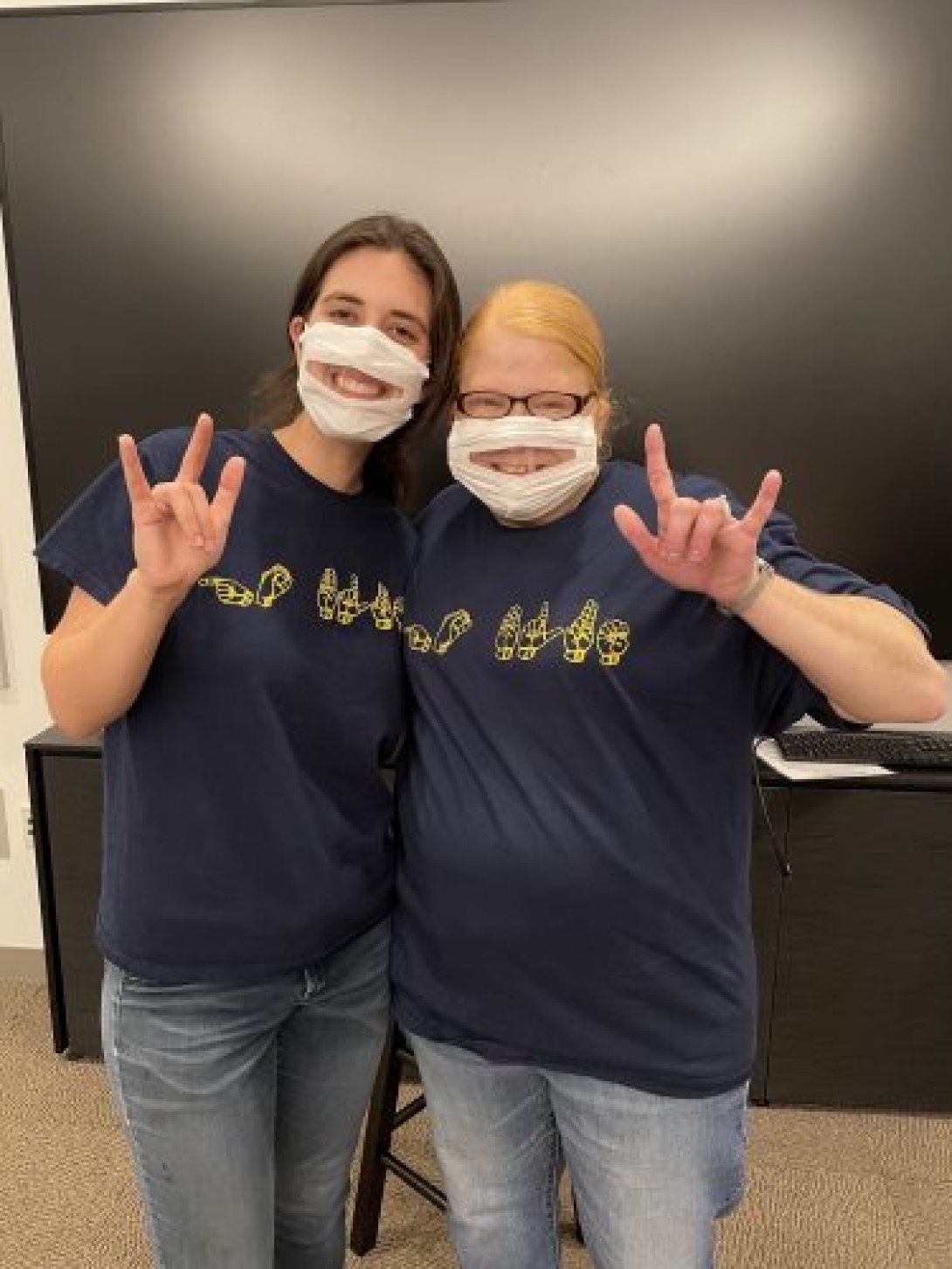
To start the process, we needed all hands on deck. Our team began brainstorming ideas, emailing school administrators and searching for funding sources. I sought advice from student leaders of the medical Mandarin and Spanish electives and pitched the course to a Zoom room filled with faculty. By June, the course was officially approved, allowing us to share the instructor job description on various social media platforms. After reviewing several resumes and interviewing applicants, we were fortunate to hire Professor Julia Shields — a Kalamazoo resident, experienced ASL instructor and member of the Deaf community.
The summer break proved to be an ideal time to prepare for the elective. I spent many hours working with Professor Shields on curriculum development and recruitment materials. After first-year medical students settled into the school year, I distributed information about the elective along with an interest form. With such a new elective, I was uncertain about the level of commitment we would receive. Thus, I was moved by the 44 students who completed the form, nearly one quarter of the first-year class! Although that number declined due to other passions and limited time, 22 enthusiastic medical students officially enrolled.
First-year medical students join Kate and Professor Shields for a class picture, posing with the sign for "I LOVE YOU."
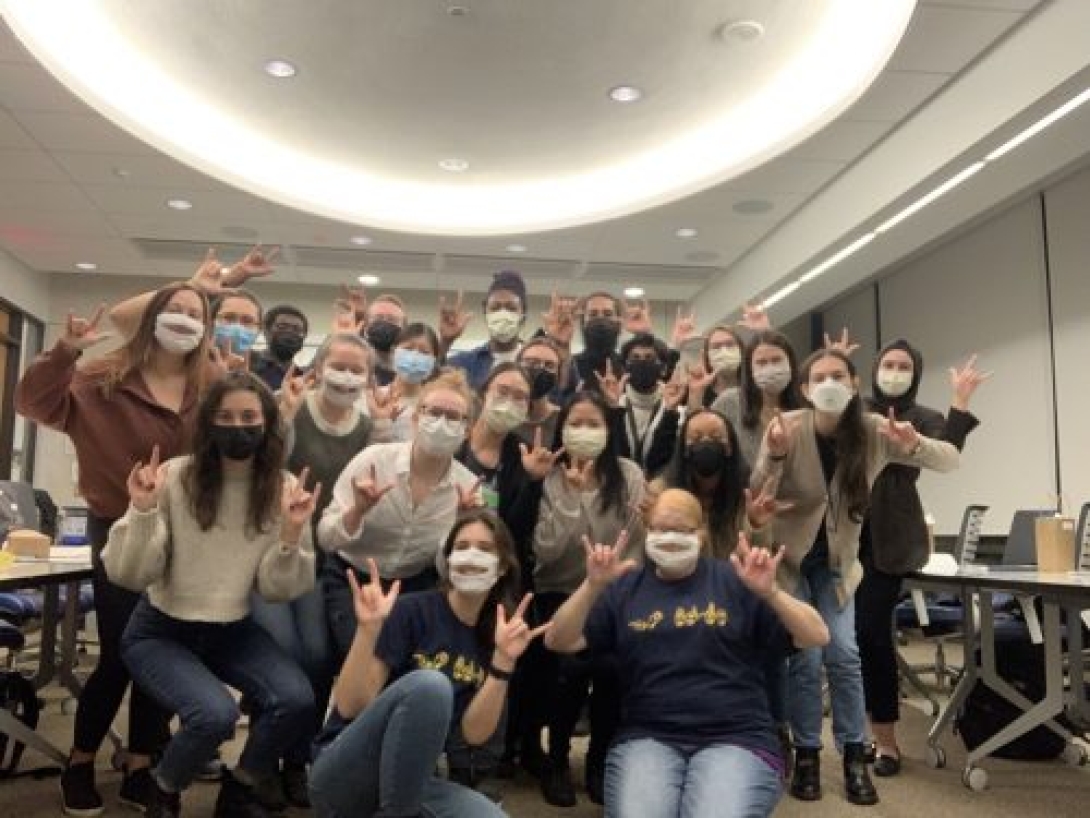
After ten months of planning and countless hours of preparation, the inaugural ASL elective developed into a 10-week course for first-year medical students to learn basic ASL and explore topics of Deaf culture and health inequities. During twice weekly in-person and virtual class sessions, students would leave behind their Anki flashcards and lecture slides to enter a quiet space filled with visual cues and hands-on learning. For many of the students, this class was their first exposure to ASL and Deaf culture and their first meaningful interaction with a Deaf ASL-user as the instructor.
Throughout the course, the students learned hundreds of signs, ranging from numbers and colors to holidays and medical terms. After learning basic ASL fingerspelling, vocabulary and grammar, they eagerly practiced by describing their family trees with neighboring classmates. They soaked in the stories shared by a Deaf Patient Panel and explored effective communication with a certified ASL interpreter. For the final exam, they studied with classmates and flexed their receptive skills on paper. These students took time from their busy schedules to participate in this class, and I am incredibly thankful for their interest and commitment to improving the healthcare experiences of Deaf patients.
Now that the course has come to an end, I'd like to share what I learned along the way. To anyone who hopes to develop a similar elective, here are three factors that are crucial to making it happen: (1) the team, (2) the institutional support and (3) the dedication.
THE TEAM Our team consisted of six passionate members, including medical students, physicians, ASL interpreters and an instructor who all contributed their unique strengths. Drs. Michael McKee and Philip Zazove from the Deaf Health Clinic provided essential perspectives as ASL-fluent physicians, prominent disability advocates and Deaf individuals. Christa Moran and Leslie Pertz are both medical ASL interpreters with extensive experience bridging the communication gap between patients and providers. Julia Shields, an ASL instructor, brought several years of teaching experience and her lived experiences as a Deaf person. Dr. Alexa Minc, a fourth-year medical student at the time, contributed her institutional knowledge to obtain funding and administrative support. As a first- and second-year medical student, I led the processes of acquiring course approval, interviewing candidates, recruiting students and served as a Teaching Assistant for the elective. Overall, this course would not have been successful without the diversity of perspectives and experiences that each member brought to the team.
THE INSTITUTIONAL SUPPORT In addition to a strong team, the ASL elective benefited from both financial and administrative support from UMMS. To obtain funding, Dr. Minc applied for a Capstone for Impact Grant. Such grants support capstone projects, which are a graduation requirement for all UMMS students. Once approved, this grant provided funding to compensate an ASL instructor for the 10-week elective. Additionally, I received an M1 Summer Impact Accelerator grant to develop and coordinate the ASL elective. Upon course approval, administrators assisted with setting up a Canvas course site and promoting the elective. This support from UMMS was an essential step in hiring an instructor and ensuring the course ran smoothly.
THE DEDICATION From the early brainstorming sessions in January to the last class session in December, each and every person involved showed unwavering dedication to the elective. UMMS faculty and administrators helped to approve and sustain the technical operations. Team members stepped up to interview potential instructors and organize guest presentations. The ASL instructor developed a new curriculum and spent hours driving from Kalamazoo to Ann Arbor for in-person classes. Several students went above and beyond to request additional learning opportunities and expressed interest in a second ASL elective in the spring. These individuals truly embody the "Michigan Difference" that made this elective so special.
So, what's next for the ASL elective? My team is currently gathering student feedback to improve the course for future participants. This feedback will be central to gaining continued support from UMMS and obtaining consistent funding for an ASL instructor. By popular demand, we plan to offer the ASL elective each fall and develop a spring course that builds on students' foundational knowledge. In the future, we hope to create educational opportunities for all medical students, faculty and staff at Michigan Medicine, and promote the development of similar electives at other institutions through presentations and publications.
The ASL elective has been a large stepping stone in my journey to improving access to health care for people with disabilities. Planning and implementing this course has made me feel challenged, humbled and supported. Various ASL students have told me that this course was a bright spot in their M1 year, which has warmed my heart tremendously. Most of all, I hope this course ultimately helps these students form unique connections with their future Deaf patients — a form of healing that extends beyond medical treatment.
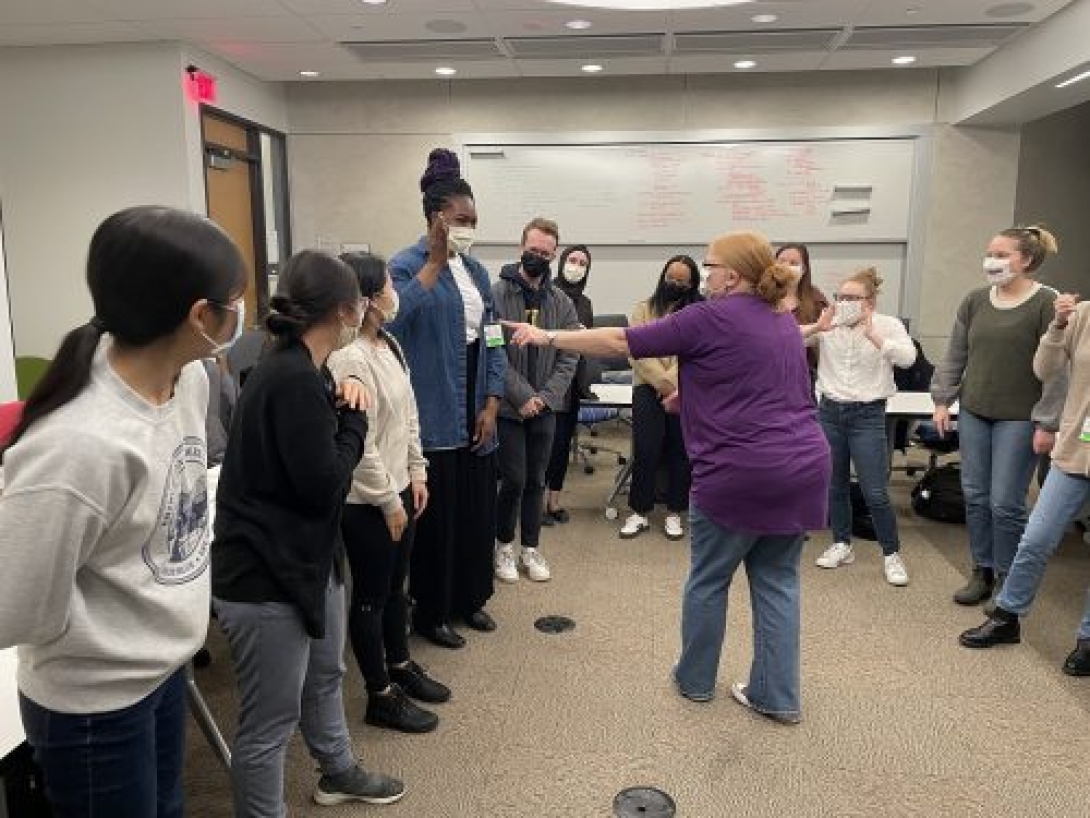
University of Michigan Medical School
Want top health & research news weekly? Sign up for Health Lab’s newsletters today!

